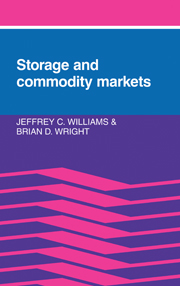Book contents
- Frontmatter
- Contents
- Preface
- Acknowledgments
- 1 Introduction
- Part I The basic model
- Part II Implications of storage for research on time series
- Part III Extensions of the model
- Part IV Public interventions
- 12 Welfare analysis of market stabilization
- 13 Floor-price schemes
- 14 Public storage under price bands and price pegs
- 15 Public policies to supplement private storage
- Part V Epilogue
- References
- Author index
- Subject index
13 - Floor-price schemes
Published online by Cambridge University Press: 03 February 2010
- Frontmatter
- Contents
- Preface
- Acknowledgments
- 1 Introduction
- Part I The basic model
- Part II Implications of storage for research on time series
- Part III Extensions of the model
- Part IV Public interventions
- 12 Welfare analysis of market stabilization
- 13 Floor-price schemes
- 14 Public storage under price bands and price pegs
- 15 Public policies to supplement private storage
- Part V Epilogue
- References
- Author index
- Subject index
Summary
Markets for storable commodities are often subject to public interventions in the name of market stabilization, including price supports, price ceilings, prohibitions on private hoarding, marketing boards, and production controls. Often such measures are really designed to redistribute income among producers, consumers, and the public treasury by raising or lowering mean price. Others, however, are plausibly aimed at stabilization, because they do not directly interfere with sales to consumers when price is around its mean level.
Even those interventions ostensibly for stabilization can result in substantial transfers between risk-neutral consumers and producers. Indeed, they can change mean price. Hence, consumers and producers need not be risk averse with respect to fluctuations in income to be affected by market-stabilizing interventions. Also, if there is a complete and otherwise undistorted set of markets, a market-stabilizing intervention causes a social deadweight loss; the degree of instability resulting from undistorted private storage is optimal given the cost of storage. Thus, for any market-stabilizing intervention there are questions about its allocative and welfare effects.
Types of market-stabilizing price supports
Three common types of scheme aimed at keeping the price paid to producers at or above a support level are distinguished by the method of market intervention. In one, the government pays producers deficiency payments, which consist of the difference, if positive, between a “target price” PD and the market price Pt paid by consumers in period t. Under this scheme, the producer price = Max[Pt,PD]. In another type of scheme the government itself stores the commodity.
- Type
- Chapter
- Information
- Storage and Commodity Markets , pp. 358 - 390Publisher: Cambridge University PressPrint publication year: 1991



